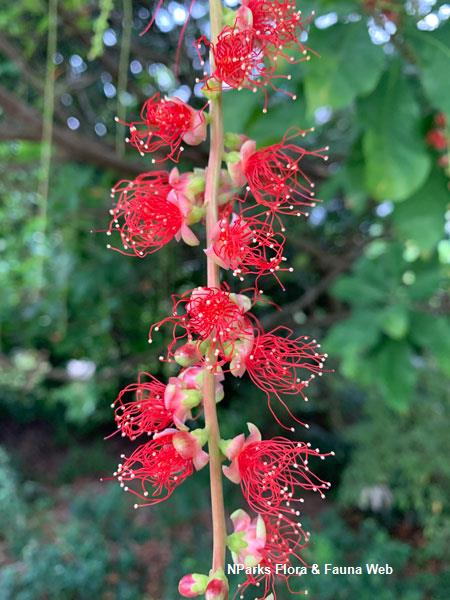
Back
Barringtonia papuana Lauterb.
| Family Name: | Lecythidaceae |
| Synonyms: | Barringtonia josephstaalensis |
| Common Name: | Kun-job, Sehsegeh |
Barringtonia papuana, also known as Kun-job in Maian, has showy flowers with numerous filamentous stamens that are pink or creamy yellow. The bark is used as fish poisons as it contains toxic saponins.
Name
Classifications and Characteristics
| Plant Division | Angiosperms (Flowering Seed Plants) |
|---|---|
| Plant Growth Form | Tree (Small (6m-15m)) |
| Lifespan (in Singapore) | Perennial |
| Mode of Nutrition | Autotrophic |
| Maximum Height | 10 m |
Biogeography
| Native Distribution | Papua New Guinea |
|---|---|
| Native Habitat | Terrestrial |
| Preferred Climate Zone | Tropical |
| Local Conservation Status | Non-native |
Description and Ethnobotany
| Growth Form | It is a small tree, up to 10 m tall. |
|---|---|
| Foliage | Clustering at the end of the branches, leaves are lanceolate (47 – 126 cm long and 1.5 – 8 cm wide) and papery, with tooth margin. There are 70 – 95 pairs of secondary veins which forms loops near the margin. Petiole is 1.5 – 12 cm long. |
| Flowers | Inflorescence occurs at the trunk or branches. Each inflorescence is about 3 – 14 cm long, and comprises of 10 flowers. Each flower (2 – 3 cm long) comprises of 4 white petals, numerous creamy pink stamens, and a ring like disc. |
| Fruit | Fruit is ovoid (6 cm long and 3 cm wide), ripens yellowish brown with flattened hairs, and contains 1 seed. |
| Habitat | It is found along rivers in primary and secondary forest. |
| Ethnobotanical Uses | Others: The bark is used as a fish poison by Maian natives. |
Landscaping Features
| Desirable Plant Features | Ornamental Foliage |
|---|---|
| Landscape Uses | Coastal |
Fauna, Pollination and Dispersal
| Pollination Method(s) | Biotic (Fauna) |
|---|---|
| Seed or Spore Dispersal | Biotic (Fauna) |
Plant Care and Propagation
| Light Preference | Full Sun, Semi-Shade |
|---|---|
| Water Preference | Moderate Water |
| Plant Growth Rate | Moderate |
| Rootzone Tolerance | Well-Drained Soils |
Foliar
| Mature Foliage Colour(s) | Green |
|---|---|
| Prominent Young Flush Colour(s) | Red |
Image Repository
Others
| Master ID | 32829 |
|---|---|
| Species ID | 7242 |
| Flora Disclaimer | The information in this website has been compiled from reliable sources, such as reference works on medicinal plants. It is not a substitute for medical advice or treatment and NParks does not purport to provide any medical advice. Readers should always consult his/her physician before using or consuming a plant for medicinal purposes. |


_lowres.jpg)





_lowres.jpg)
_lowres.jpg)

_lowres.jpg)
_lowres.jpg)

_lowres.jpg)